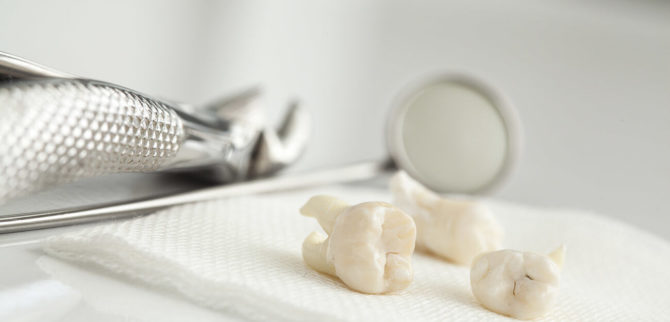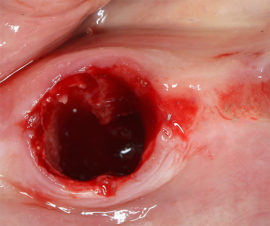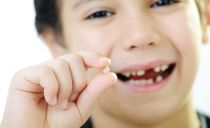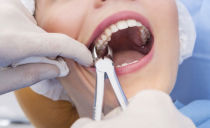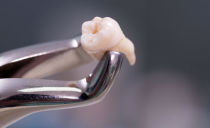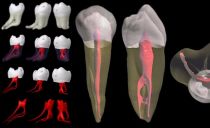Bleeding after tooth extraction: reasons to stop at home
Extraction is accompanied by damage to blood vessels, periodontal, nerve bundles in the apical foramen and blood secretion. Usually bleeding stops within an hour. During this time, a clot forms in the hole, which contributes to the healing of the wound and prevents its infection. But sometimes it lasts longer than it should be. In such a situation, it does not hurt to know how to stop the blood after tooth extraction at home.
Content
- What should be done at the end of the extraction and why
- How much blood goes after tooth extraction
- Long blood flows from the hole of the extracted tooth: causes and types of bleeding
- They pulled out a tooth - the blood does not stop: what to do
- How much can not be eaten after extraction and why
- Blood flows after removing a wisdom tooth
What should be done after extraction is completed and why
Upon completion of the extraction, the dentist cleans and disinfects the hole that formed on the site of the extracted tooth, and then stops the bleeding with a gauze swab - tamponade. Keep it no longer than half an hour, since a dirty bandage is an excellent medium for the propagation of pathogenic microorganisms. After removing the wisdom tooth, bleeding can last longer than when removing other molars, in which case the tampon is periodically replaced with a new, clean one.
After about 3 hours, a strong blood clot forms in the well that cannot be damaged. That is why you can’t eat and drink right after the extraction is complete and you should refuse to eat solid food at least for the next day. Products containing friable components should not be consumed for at least a few days, as they can get into the wound, get stuck in it and provoke the development of inflammation.
If the operation was difficult, a large area of the gum is damaged, its edges are badly torn, the dentist will stitch. They will help the clot that forms after tooth extraction, stay in the alveolus and stop the blood from the gums. If a purulent anemone forms in the gum, do not try to pull it out - you should immediately consult a dentist.
How much blood goes after tooth extraction
Normally, blood flows for 30 minutes after surgery, but minor hemorrhages can last up to 5-6 hours. If saliva is slightly colored red for 24 hours, you should not panic. If after this period the wound is still bleeding, attach a swab to it or a clean, folded and moistened tissue handkerchief. Edema and pain in the area of the socket are acceptable, but only if they are not accompanied by other symptoms, for example, high temperature (more than 38.5 ° C) or difficulty swallowing.
With abundant repeated flow of blood from the hole and with severe pain, even if such symptoms appear only after 1-2 days, you should definitely consult a dentist.
In the postoperative period, painkillers containing acetylsalicylic acid (aspirin tablets) should not be taken, since they have a liquefying effect - the gums will begin or continue to bleed. Other painkillers can be used at any time, taking into account the contraindications and recommendations received during the consultation in dentistry.
Blood flows after tooth extraction due to gum injury, violation of the integrity of blood vessels, periodontal and nerve bundles in the apical opening.For the wound to heal, the hole must be filled with a blood clot.
A correct blood clot is a cherry-colored formation that begins to form approximately 30 minutes after extractionfollowing the application of a sterile compression dressing. After 24 hours, it becomes covered with fibrinous exudate and turns gray.
Long blood flows from the hole of the extracted tooth: causes and types of bleeding
Bleeding from a hole in a extracted tooth has a different character:
- parenchymal blood seeps from the entire surface of venous wounds;
- dark red blood flows evenly;
- arterial bright red blood flows in a strong pulsating flow.
By time (period) of the occurrence of bleeding is divided into 2 types:
- early - opening immediately after the tooth is pulled out, or occurring within 24 hours;
- later - starting the next day or after a few days (with hemophilia on days 5 and 6).
Small hemorrhages, which begin after about 2–4 hours, often open due to the administration of large doses of anesthetics: adrenaline in their composition provokes a temporary narrowing of the vessels. Narrowed vessels continue to contract, which can lead to hemorrhage and excrement of the sacrum.
The reasons due to which the blood does not stop after tooth extraction are local:
- gross and violent manipulations with sharp instruments;
- trauma or damage to soft tissues in the oral cavity;
- bone fragmentation or fragmentary fracture of the alveolar bone;
- anatomical abnormalities in the structure of blood vessels;
- mechanical trauma of the formed clot (during eating).
Often, blood flows at the end of the procedure to remove the tooth in women during menstruation, which may be associated with a disorder of hemostasis or with hemorrhagic diathesis (increased tendency of the body to bleed). Other factors that negatively affect the vascular wall and contribute to the prolonged release of blood are:
- atherosclerosis;
- exposure to chemical toxic agents;
- infectious, viral and bacterial diseases;
- neoplasms;
- leukopenia;
- allergy;
- deficiency of vitamins PP and C;
- decrease in platelet count - thrombocytopenia;
- blood pathology (anemia);
- liver disease
- hypertonic disease;
- rheumatic diseases;
- diabetes.
They pulled out a tooth - the blood does not stop: what to do
In outpatient practice, there are long non-healing wounds. It is difficult to stop severe bleeding after tooth extraction at home, you need to go to the dentist who will provide first aid and determine whether the blood constantly flows or periodically when the phenomenon started: immediately after the extraction is completed or after a certain time.
In addition, the doctor will collect data on concomitant diseases and ask the patient about how the healing of other wounds occurs, if there are hemorrhagic pathologies in the family in which blood coagulation is impaired. After analyzing the information received, the doctor will draw up a plan for further action.
If the blood does not go much after tooth extraction, you can try to stop it with the help of oral baths - holding cold water in your mouth, a cool decoction of chamomile or sage. These drugs will help in the rapid healing of the wound, as well as protect it from infections. You can not rinse your mouth - you can wash the blood clot.
In order for the wound channel to heal properly, you need to resort to such methods of stopping blood flowing from the hole:
- Within 15-20 minutes after pulling out the tooth, press a tampon to stop the bleeding. After this time, the compress is removed, since the compression of the wound for 30 minutes leads to adverse results.
- Do not eat before and during anesthesia (about 2 hours). For two days you can’t eat only cold dishes and drink drinks through a straw.
- Brush teeth on the day of extraction, removing plaque only from healthy teeth.
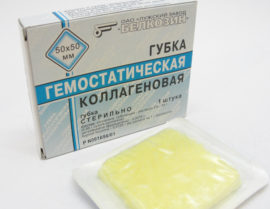 Use a hemostatic hemostatic sponge, which is sold in pharmacies. It will disinfect the wound and accelerate the process of tightening the hole.
Use a hemostatic hemostatic sponge, which is sold in pharmacies. It will disinfect the wound and accelerate the process of tightening the hole.- After 24 hours, carefully rinse your mouth with a pharmaceutical rinse, antiseptic, home-made sage broth, slightly salted water or a solution of hydrogen peroxide (1 tablespoon of peroxide is diluted in half a glass of water).
- Make oral baths. It should be remembered that vigorous prolonged rinsing of the mouth can damage a thin clot, after this the hole formed after tooth extraction will again begin to bleed.
- Avoid physical activity and exposure to high temperatures for 48 hours.
- Do not use any stimulants within 24 hours after the tooth has been removed.
How to stop bleeding after tooth extraction at home
The following recommendations will help eliminate the symptom of increased bleeding:
- Cool the area of the oral cavity that has been exposed to surgery. As a result of such actions, the joints contract, pressure and swelling decrease. Cooling is best done with a cold wet compress or with a small pillow, but not with ice. Apply cooked lotions for ten minutes every three hours. In some cases, longer cooling may be required.
- After the tooth is pulled out, avoid heat (direct sunlight, sauna and bath) for the first few days.
- Do not stimulate blood circulation. To avoid high blood pressure, do not drink alcohol, coffee, or black tea for the first 24 hours. You should also take away cigarettes.
- Do not do sports or other exercise for three days.
- Speak less, it helps to heal a wound.
- Use hemostatic drugs, for example, Vikasol, only on the recommendation of a therapist, who must necessarily find out that the patient has gum bleeding after the tooth is pulled out.
- At night, keep your head as high as possible, this can be achieved with an extra pillow.
How much can not be eaten after extraction and why
Immediately after pulling out the dental unit, you can’t eat, you should wait at least a few hours. Under still existing anesthesia, the patient is not able to control the process of biting off food, therefore, it can damage the cheeks, lips or even burn yourself, without realizing it. You should refrain from eating solid foods and hot drinks. During the first three days, you can only eat soft, not too hot food, so as not to disrupt the healing of the wound and not endanger the clot formed in the hole.
If the blood does not stop, despite observing all the rules voiced by the dentist regarding postoperative oral care and nutrition, consult a doctor or emergency service immediately.
Blood flows after removing a wisdom tooth
Usually, after removing the eighth tooth, the gums continue to bleed for several minutes until a clot forms. Then the flowing blood does not stop completely, but begins to stand out in a smaller volume. If the blood cannot be stopped, you should immediately consult a dentist.
When hemorrhages do not begin immediately after extracting the wisdom tooth, but during the first 24 hours, it is a matter of primary bleeding. It is very common in patients who have had an oral operation. Usually this condition does not threaten health, lasts either tens of minutes or several hours. Postoperative bleeding can be observed even in patients with the correct value of the parameters that determine blood coagulation.

